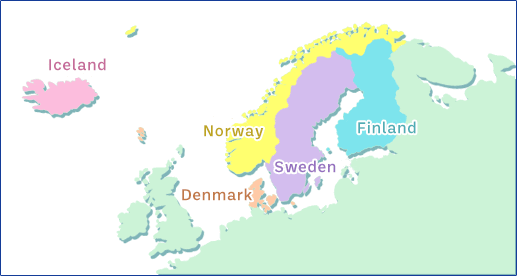
Yogurt in Northern Europe
Iceland / Sweden / Denmark / Norway / Finland

- Scandinavia
- In Scandinavia, people used to make fermented milk by quite an extraordinary method. As the story goes, they fermented milk by harvesting the leaves of carnivorous plants indigenous to the region such as common sundew and common butterwort, laying them at the bottom of a container, pouring milk on top of them, and letting it sit for the desired natural process to run its course. These people knew that the leaves of those particular plant species were inhabited by lactic acid bacteria. Although this traditional method is no longer used today, traditional fermented milks that are thick and sticky in consistency and unique to the region are still produced and consumed today (such as tettemelk, langfil, and pitkapiima). Their viscosity is created by a strain of lactic acid bacteria called Lactococcus lactis subsp. cremoris.
Iceland
The most famous fermented milk product unique to Iceland is skyr, which has existed in the country for more than 10 centuries, and is made by mixing and curdling skim milk with lactic acid bacteria and rennet (i.e., an enzyme that facilitates curdling) in a hemp sack, and later removing the whey. It is usually eaten for breakfast and snacks, with sugar, cream, milk, and strawberries mixed in.
Sweden
Sweden has its own unique fermented milk product called langfil, which is thick in consistency and typically made in the country’s northern region or Lapland. It is usually eaten for breakfast with cornflakes, etc. The country also produces large quantities of filmjölk, which is another traditional cultured dairy, made by fermenting milk with mesophilic lactic acid bacteria (i.e., butter starter) that are also used to make fermented butter. Sweden is also home to lactofil, a condensed fermented milk product with high protein content, which is similar to the Danish fermented milk product, ymer.
Denmark
The most popular fermented milk product made and consumed in Denmark is ymer, which is produced either by fermenting milk and removing whey from it afterwards, or by fermenting milk that is precondensed by reverse osmosis. It is characterized by having a protein content of at least 6%. Ymer has a very mild texture and rich flavor, and is typically eaten for breakfast with cornflakes or porridge (such as oatmeal). Tykmaelk is another cultured dairy product widely consumed in Denmark, which is made by fermenting milk with butter starters.
Norway
Tettemelk is a fermented milk product made in Norway, which has a thick consistency and very sour flavor. As tettemelk used to be made by pouring milk into well-washed barrels and fermenting in underground cellars, it is also called “cellar milk.” Tettemelk is known for its ability to be stored for a long time while refrigerated in such a condition. Melkering is a type of cultured dairy product popular in the country, which is made with mesophilic lactic acid bacteria (cultured in the temperature range between 20 and 30℃).
Finland
In Finland, many people consume a cultured dairy product called piima, which is made by fermenting milk with mesophilic lactic acid bacteria. The highly viscous variation of piima that is traditionally produced in southwestern Finland is called pitkapiima. Viili is another Finnish cultured milk product, which is made by fermenting milk with lactic acid bacteria in a certain way that allows velvety milk fungi to grow on the surface of the cream that forms on top. It is one of the world’s rare cultured dairy products that use fungi, and features a thick texture, mildly sour taste, and pungent flavor. Viili is consumed for breakfast and snacks, and children usually have it with sugar and cinnamon sprinkled on top. In the eastern region of Finland, people consume a condensed cultured milk called kokkelipiima, which is traditionally made by fermenting milk, and heating it in the oven to remove the whey. It keeps well and is drunk after adding some milk to thin it.



















